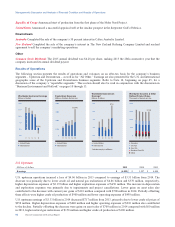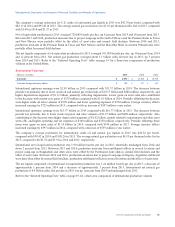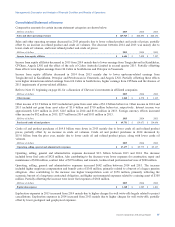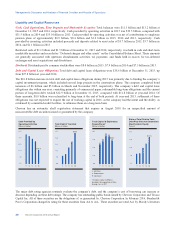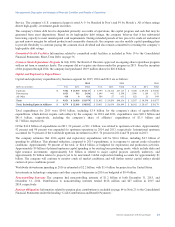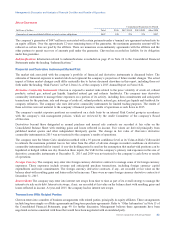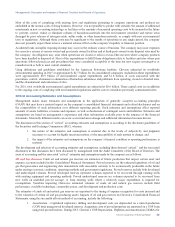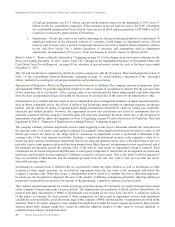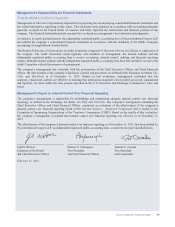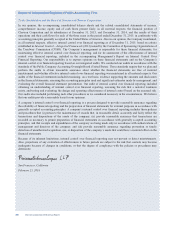Chevron 2015 Annual Report Download - page 26
Download and view the complete annual report
Please find page 26 of the 2015 Chevron annual report below. You can navigate through the pages in the report by either clicking on the pages listed below, or by using the keyword search tool below to find specific information within the annual report.
Management’s Discussion and Analysis of Financial Condition and Results of Operations
Litigation and Other Contingencies
MTBE Information related to methyl tertiary butyl ether (MTBE) matters is included on page 50 in Note 17 to the
Consolidated Financial Statements under the heading “MTBE.”
Ecuador Information related to Ecuador matters is included in Note 17 to the Consolidated Financial Statements under the
heading “Ecuador,” beginning on page 50.
Environmental The following table displays the annual changes to the company’s before-tax environmental remediation
reserves, including those for federal Superfund sites and analogous sites under state laws.
Millions of dollars 2015 2014 2013
Balance at January 1 $ 1,683 $ 1,456 $ 1,403
Net Additions 365 636 488
Expenditures (470) (409) (435)
Balance at December 31 $ 1,578 $ 1,683 $ 1,456
The company records asset retirement obligations when there is a legal obligation associated with the retirement of
long-lived assets and the liability can be reasonably estimated. These asset retirement obligations include costs related to
environmental issues. The liability balance of approximately $15.6 billion for asset retirement obligations at year-end 2015
related primarily to upstream properties.
For the company’s other ongoing operating assets, such as refineries and chemicals facilities, no provisions are made for exit
or cleanup costs that may be required when such assets reach the end of their useful lives unless a decision to sell or
otherwise abandon the facility has been made, as the indeterminate settlement dates for the asset retirements prevent
estimation of the fair value of the asset retirement obligation.
Refer to the discussion below for additional information on environmental matters and their impact on Chevron, and on the
company’s 2015 environmental expenditures. Refer to Note 24 on page 66 for additional discussion of environmental
remediation provisions and year-end reserves. Refer also to Note 25 on page 67 for additional discussion of the company’s
asset retirement obligations.
Suspended Wells Information related to suspended wells is included in Note 21 to the Consolidated Financial Statements,
Accounting for Suspended Exploratory Wells, beginning on page 57.
Income Taxes Information related to income tax contingencies is included on pages 53 through 56 in Note 18 and page 65 in
Note 24 to the Consolidated Financial Statements under the heading “Income Taxes.”
Other Contingencies Information related to other contingencies is included on page 66 in Note 24 to the Consolidated
Financial Statements under the heading “Other Contingencies.”
Environmental Matters
The company is subject to various international, federal, state and local environmental, health and safety laws, regulations
and market-based programs. These laws, regulations and programs continue to evolve and are expected to increase in both
number and complexity over time and govern not only the manner in which the company conducts its operations, but also the
products it sells. For example, international agreements (e.g., the Paris Accord and the Kyoto Protocol) and national (e.g.,
carbon tax, cap-and-trade, or efficiency standards), regional, and state legislation (e.g., California’s AB32 or other low
carbon fuel standards) and regulatory measures (e.g., the U.S. Environmental Protection Agency’s methane performance
standards) to limit or reduce greenhouse gas (GHG) emissions are currently in various stages of discussion or
implementation. Consideration of GHG issues and the responses to those issues through international agreements and
national, regional or state legislation or regulation are integrated into the company’s strategy, planning and capital investment
reviews, where applicable. They are also factored into the company’s long-range supply, demand and energy price forecasts.
These forecasts reflect long-range effects from renewable fuel penetration, energy efficiency standards, climate-related
policy actions, and demand response to oil and natural gas prices. In addition, legislation and regulations intended to address
hydraulic fracturing also continue to evolve at the international, national and state levels. Refer to “Risk Factors” in Part I,
Item 1A, on pages 21 through 23 of the company’s Annual Report on Form 10-K for a discussion of some of the inherent
risks of increasingly restrictive environmental and other regulation that could materially impact the company’s results of
operations or financial condition.
24 Chevron Corporation 2015 Annual Report


